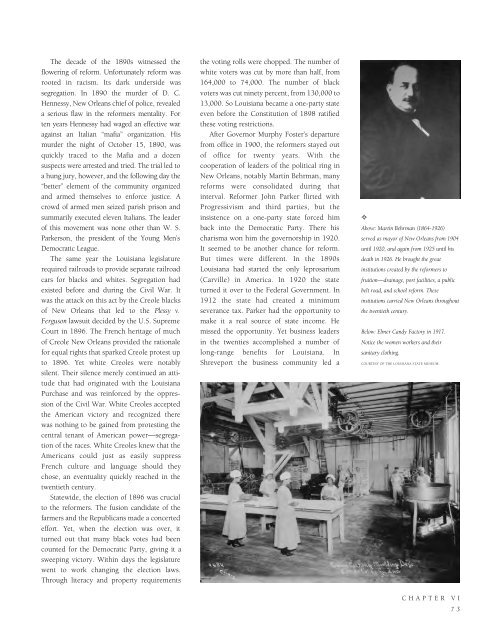Historic Louisiana
An illustrated history of Louisiana, paired with the histories of companies, families and organizations that make the state great.
An illustrated history of Louisiana, paired with the histories of companies, families and organizations that make the state great.
You also want an ePaper? Increase the reach of your titles
YUMPU automatically turns print PDFs into web optimized ePapers that Google loves.
The decade of the 1890s witnessed the<br />
flowering of reform. Unfortunately reform was<br />
rooted in racism. Its dark underside was<br />
segregation. In 1890 the murder of D. C.<br />
Hennessy, New Orleans chief of police, revealed<br />
a serious flaw in the reformers mentality. For<br />
ten years Hennessy had waged an effective war<br />
against an Italian “mafia” organization. His<br />
murder the night of October 15, 1890, was<br />
quickly traced to the Mafia and a dozen<br />
suspects were arrested and tried. The trial led to<br />
a hung jury, however, and the following day the<br />
“better” element of the community organized<br />
and armed themselves to enforce justice. A<br />
crowd of armed men seized parish prison and<br />
summarily executed eleven Italians. The leader<br />
of this movement was none other than W. S.<br />
Parkerson, the president of the Young Men’s<br />
Democratic League.<br />
The same year the <strong>Louisiana</strong> legislature<br />
required railroads to provide separate railroad<br />
cars for blacks and whites. Segregation had<br />
existed before and during the Civil War. It<br />
was the attack on this act by the Creole blacks<br />
of New Orleans that led to the Plessy v.<br />
Ferguson lawsuit decided by the U.S. Supreme<br />
Court in 1896. The French heritage of much<br />
of Creole New Orleans provided the rationale<br />
for equal rights that sparked Creole protest up<br />
to 1896. Yet white Creoles were notably<br />
silent. Their silence merely continued an attitude<br />
that had originated with the <strong>Louisiana</strong><br />
Purchase and was reinforced by the oppression<br />
of the Civil War. White Creoles accepted<br />
the American victory and recognized there<br />
was nothing to be gained from protesting the<br />
central tenant of American power—segregation<br />
of the races. White Creoles knew that the<br />
Americans could just as easily suppress<br />
French culture and language should they<br />
chose, an eventuality quickly reached in the<br />
twentieth century.<br />
Statewide, the election of 1896 was crucial<br />
to the reformers. The fusion candidate of the<br />
farmers and the Republicans made a concerted<br />
effort. Yet, when the election was over, it<br />
turned out that many black votes had been<br />
counted for the Democratic Party, giving it a<br />
sweeping victory. Within days the legislature<br />
went to work changing the election laws.<br />
Through literacy and property requirements<br />
the voting rolls were chopped. The number of<br />
white voters was cut by more than half, from<br />
164,000 to 74,000. The number of black<br />
voters was cut ninety percent, from 130,000 to<br />
13,000. So <strong>Louisiana</strong> became a one-party state<br />
even before the Constitution of 1898 ratified<br />
these voting restrictions.<br />
After Governor Murphy Foster’s departure<br />
from office in 1900, the reformers stayed out<br />
of office for twenty years. With the<br />
cooperation of leaders of the political ring in<br />
New Orleans, notably Martin Behrman, many<br />
reforms were consolidated during that<br />
interval. Reformer John Parker flirted with<br />
Progressivism and third parties, but the<br />
insistence on a one-party state forced him<br />
back into the Democratic Party. There his<br />
charisma won him the governorship in 1920.<br />
It seemed to be another chance for reform.<br />
But times were different. In the 1890s<br />
<strong>Louisiana</strong> had started the only leprosarium<br />
(Carville) in America. In 1920 the state<br />
turned it over to the Federal Government. In<br />
1912 the state had created a minimum<br />
severance tax. Parker had the opportunity to<br />
make it a real source of state income. He<br />
missed the opportunity. Yet business leaders<br />
in the twenties accomplished a number of<br />
long-range benefits for <strong>Louisiana</strong>. In<br />
Shreveport the business community led a<br />
✧<br />
Above: Martin Behrman (1864-1926)<br />
served as mayor of New Orleans from 1904<br />
until 1920, and again from 1925 until his<br />
death in 1926. He brought the great<br />
institutions created by the reformers to<br />
fruition—drainage, port facilities, a public<br />
belt road, and school reform. These<br />
institutions carried New Orleans throughout<br />
the twentieth century.<br />
Below: Elmer Candy Factory in 1917.<br />
Notice the women workers and their<br />
sanitary clothing.<br />
COURTESY OF THE LOUISIANA STATE MUSEUM.<br />
CHAPTER VI<br />
73
















